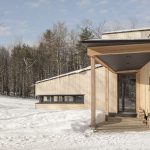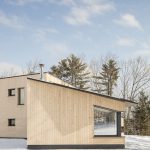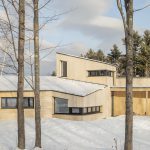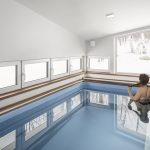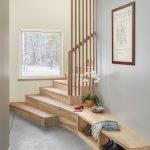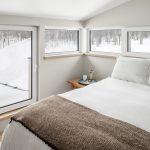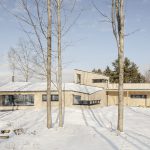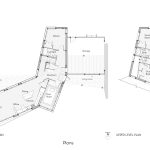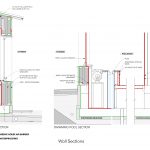Pikes Hill
Project Name
Completed 2017
1,989 square feet
Construction cost approx. $550,000
The clients purchased a large 9.5 acre lot at the top of Pikes hill in their hometown of Norway, Maine. With their new home, they had hoped to get distant mountain peak views as well as a glimpse of Lake Pennesseewassee beyond. But mostly they wanted a modestly sized home in nature that kept them warm in the coldest Maine winters while they did their daily exercises in an indoor endless pool. They also wanted a place to show off their prized collection of carved decoys.
We created a crystalline form that reflected the push and pull of the critical vectors that acted on the site: views directly to the NNW, an approach from the ESE, and of course sun from direct south. Then to reduce unnecessary volume, we peeled away the excess spaces, and scaled down any rooms that desired intimacy (the bedrooms) or did not require height (the pool room). We then chose to cover all conditioned areas with only two roof planes to visually bind the unique form.
Two-inch-deep steel sections hidden inside the roof plane allow a deep but very thin overhang at the southern corner for more shade, and provide dramatic shadow on an otherwise closely cropped form. A similar detail reoccurs at the entry porch. An incrementally tapering staircase carves a little more space away in the entry foyer and leads your eye to the main living area beyond. From the main living space, a ribbon of glass opens to the view down the hill and to the lake beyond.
The exterior features locally milled tongue-and-groove cedar in two varying directions, with gaps not only at the verticals, but at the horizontal joints as well. A super-insulated, double-stud cavity with the interior wall being structural, allows for deep window insets and wrapping, clad exterior corner sills. This high-performance home (R40 walls, R60 roof, R20 slab, heat recovery ventilation, air-source heat pumps, triple glazing, passive house-level airtightness, solar-ready) needs just a single heat pump per floor, and utilizes the gas stove only to take the edge off the coldest of nights, perhaps right after dip in the pool.
Measure 1: Design for Integration
Multiple elements provide for utility, comfort, and delight, such as the deep window recesses that provide visual richness as well as additional shading, extended extra-thin overhangs that do the same, and a taut, super-insulated form that features no leak-susceptible ridges or valleys.
Measure 2: Design for Community
The home is within 0.6 miles of where the clients work, in the center of town, about a 15-minute walk.
Measure 3: Design for Ecology
The house itself required removal of no additional trees, and allowed the existing drainage of the site to be largely maintained.
Measure 4: Design for Water
Low carbon impact fixtures are located throughout the home.
Measure 5: Design for Economy
The super insulated, net zero home was completed for approximately $275 / sf. Yearly energy costs will be reduced by 50% with this system, and eventually near 100% when the solar panels are installed.
Measure 6: Design for Energy
The home features R40 walls, R60 roof, R20 slab, heat recovery ventilation, air-source heat pumps, triple glazing, passive house-level airtightness, solar-ready, and an EUI of 24, even with a heated, endless pool. A wood-burning stove allows for peak loads to be reduced, so that only two heat pump heads feed the entire home. No fossil fuels are required in this all-electric home.
Measure 7: Design for Wellness
An endless pool allowed the occupants to get their daily exercise without concern for the rough Maine winters.
Measure 8: Design for Resources
Primary construction elements are natural materials – mostly wood and concrete. – with low embodied energy. All insulation is either cellulose or subslab EPS, and spray foam use is extremely limited.
Measure 9: Design for Change
The home’s wood stove, super-insulation, passive solar-tuned glass, and thermal mass of the slab will allow it to maintain itself without power comfortably, even on the coldest days.
Measure 10: Design for Discovery
This home has been shown in public talks that discuss the benefits of air source heat pumps at ABX in Boston and the Maine IAQ conference. It was also shown as part of the firm’s body of high-performance homes at NESEA’s BuildingEnergy conference. A post-occupancy evaluation has led to a discussion of adjusting the throw of one of the heat pump heads so that less heat escapes to the upper floor. Ultimately it was decided to leave it where it is and utilize the wood stove more as needed during prolonged frigid stretches.


